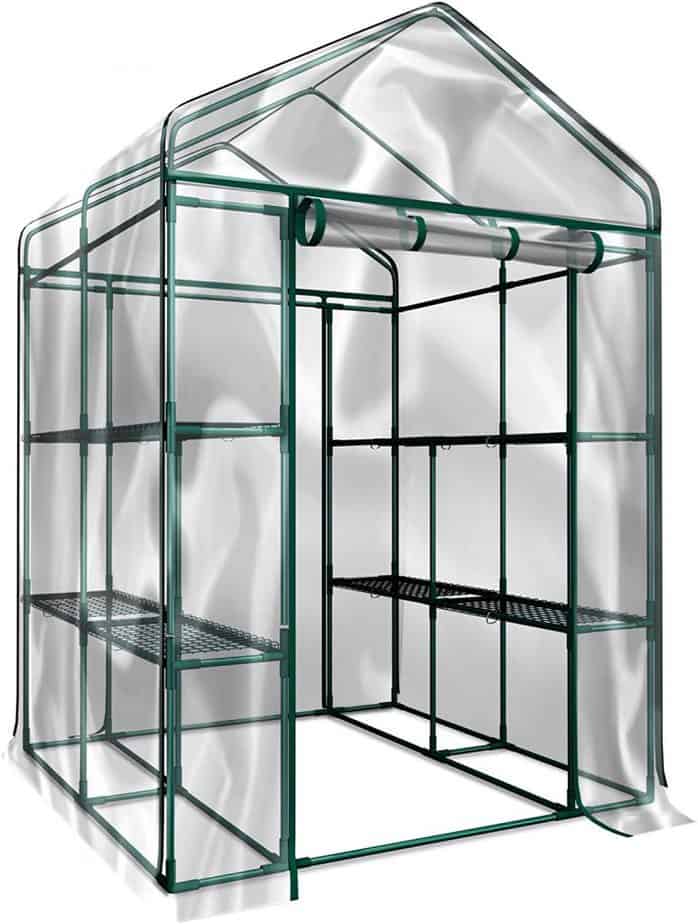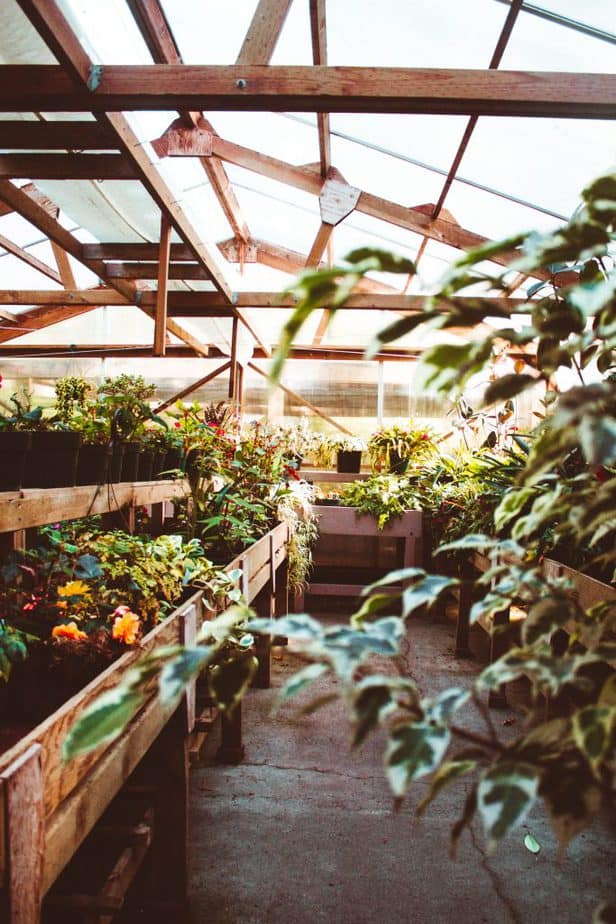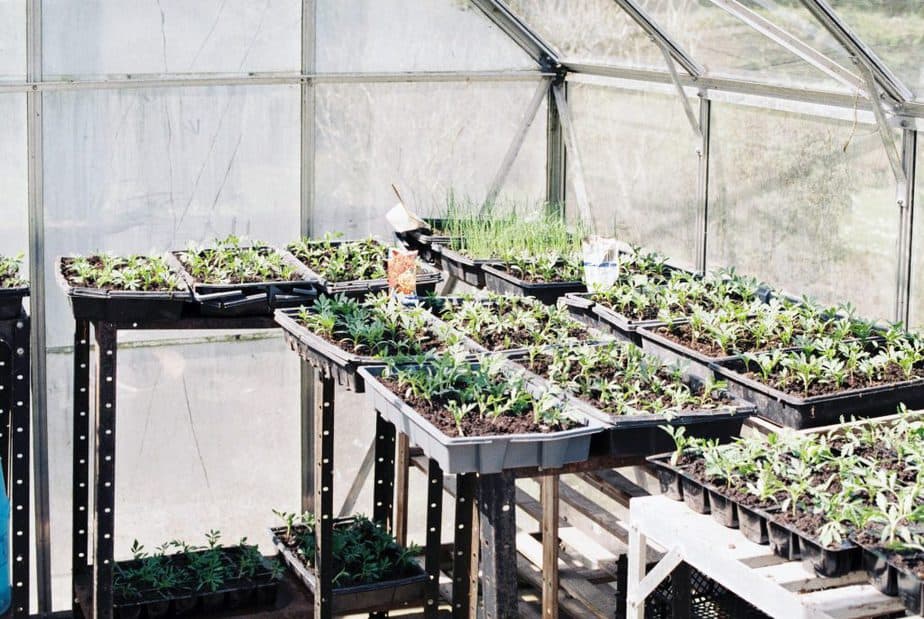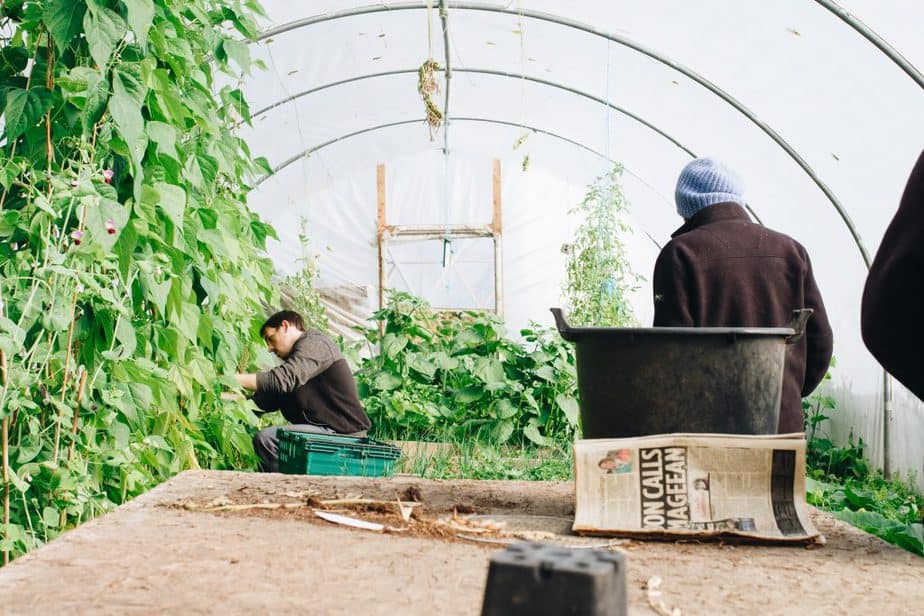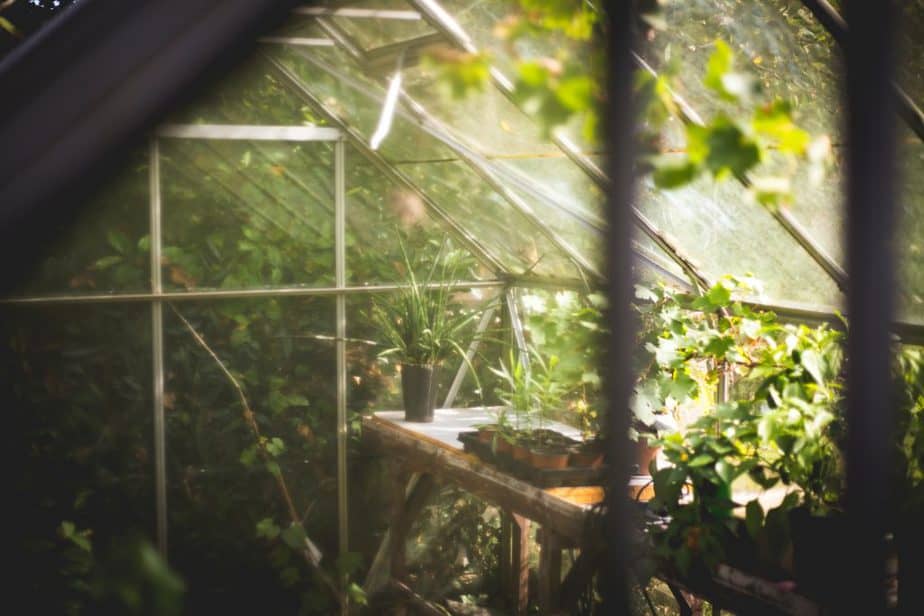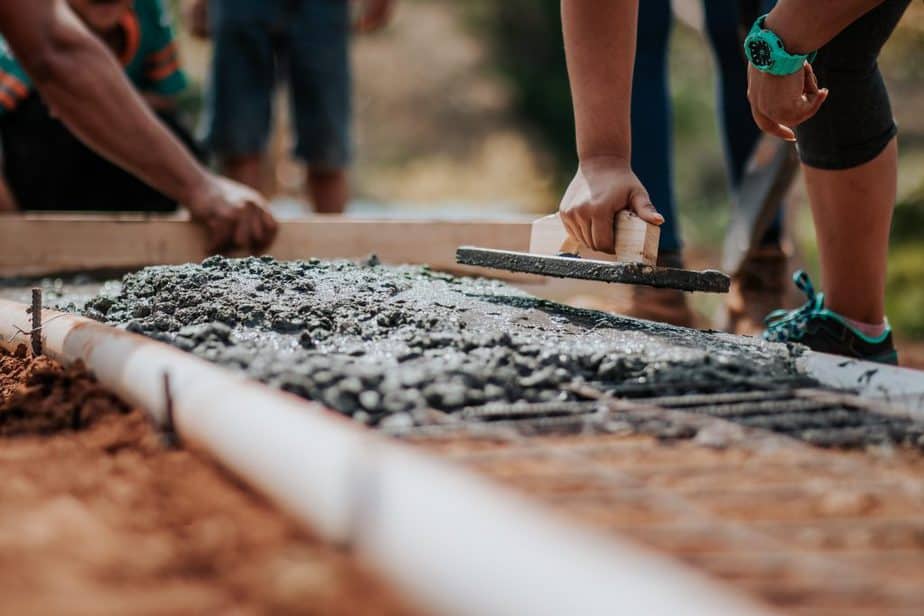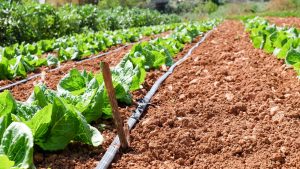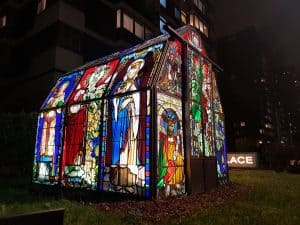Heads up – this is a really long article! It’s designed to be a primer for beginner to intermediate level growers, whether or not you’ve had the pleasure of working in a greenhouse before. We’ll cover everything you need to know before purchasing a greenhouse, as well as all of the things you’ll need to do after your greenhouse is up and running.
Ready? Let’s get growing!
What is a Greenhouse?
It seems like a silly question, but it’s crucial that we lay down some definitions before we start. There is a surprising amount of confusion and even misinformation out there regarding what is and what isn’t a greenhouse.
The definition of a greenhouse, according to Wikipedia, is:
a structure with walls and roof made chiefly of transparent material, such as glass, in which plants requiring regulated climatic conditions are grown.
And, yeah, that’s pretty much the only criteria.
People might argue with you if you say it, but the truth is that “greenhouse” is a catch-all term. It describes any transparent structure meant to aid in growing plants. There are several sub-types of greenhouse that have clear definitions distinct from one another, but the wide variety of products and designs available means that they blur together pretty often.
Types of Greenhouses
Several structures often get lumped together and called greenhouses. To be fair, they’re mostly the same, with only one or two differences. If you want more information about the different types of greenhouses on the market then give the linked guide a read.
Greenhouse
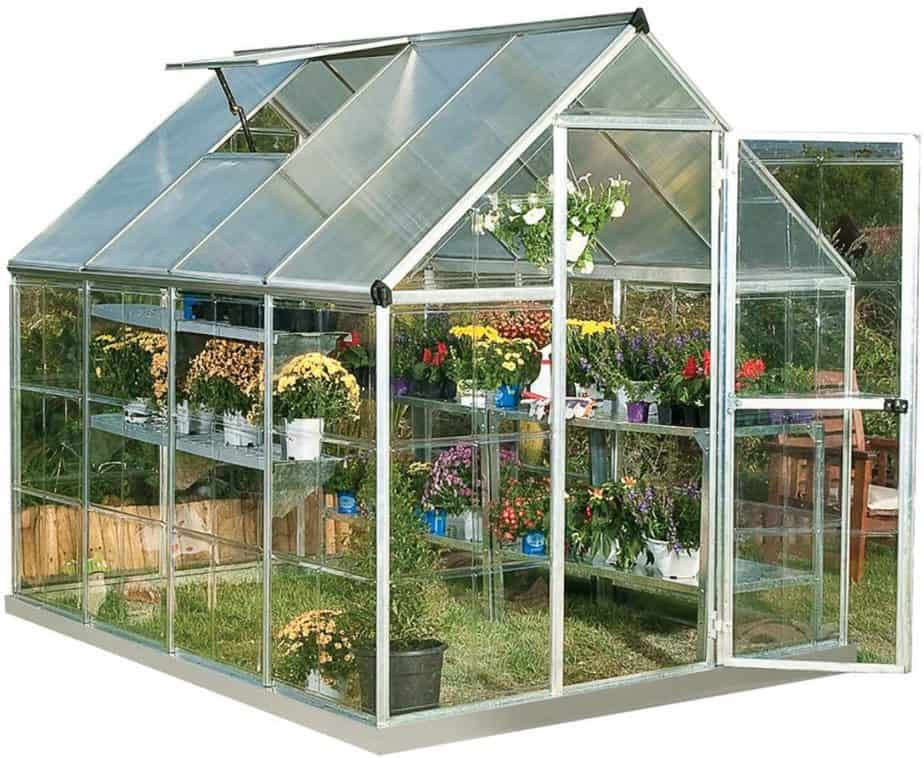
If you want to be very, very technical in an entirely unnecessary way, a greenhouse would be a structure with:
- transparent walls and roof
- no heating
- a ventilation system
If you wanted to be even more pedantic, you could expound upon the heating by saying no powered heating systems. There are lots of ways to keep a greenhouse warm, from shutting the vents to using insulation, to keeping barrels of water as “thermal batteries” to release heat overnight. If you put a space heater in there, however, it would turn into a hothouse.
What about a solar powered greenhouse? Check this out if you’re interested in learning more.
Greenhouses are typically relatively large. If it’s smaller than 8 ft by 8 ft, it’s almost certainly a coldframe. The larger the structure is, the better able it is to capture and store heat. Some are possibly too good at storing heat, to the point where it may be too hot for the plants inside or too humid. That’s why greenhouses always have ventilation, whether it’s windows or vents that open to allow airflow or a fan that circulates air while keeping the structure sealed.
Learn about your best greeenhouse ventilation options here.
Hothouse

A hothouse is just a greenhouse with a powered heating system, really. Hothouses can still come in practically any shape or size.
Unlike greenhouses, a hothouse maintains a growing temperature year-round. Usually, this gets accomplished through an electric or gas heater similar to the ones that heat homes. Some (really excellent) greenhouses use geothermal energy from the Earth or recycle heat energy from manufacturing facilities located nearby.
Practically all commercial growing operations (and many home growers!) use hothouses in some form or another. It’s the only way to continue production throughout the changing seasons. Even if you live in a desert where heating is unnecessary, you’re likely to find hothouses rather than greenhouses simply because they allow you to keep plants in precisely the optimal growing conditions.
If you want to keep calling your hothouse a greenhouse, it’s OK. We won’t tell.
Screenhouse
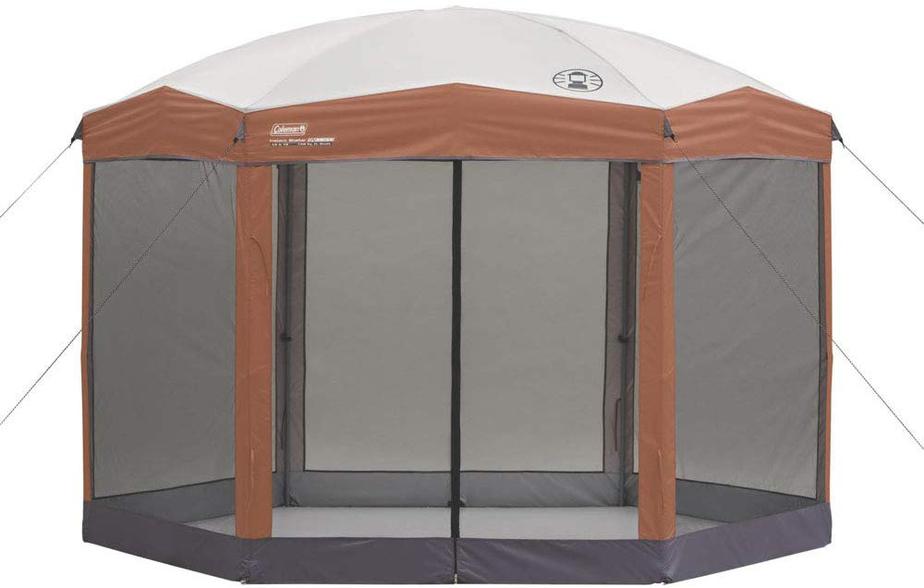
Gardening screenhouses are rarely intended for the plants – usually, it’s for the comfort or ease of the gardener. They are exactly what they sound like: a (usually opaque) canopy with walls made of mesh or screen. Screenhouses severely limit the amount of light that reaches the plants beneath. It’s only suitable for shade-loving plants.
The purpose of a screenhouse is to keep pests out, anything from mosquitoes to rabbits to deer that might threaten your plants. More often than not, the actual use of a screenhouse is a temporary structure to allow people to enjoy the outdoors (either camping or in a backyard) without the annoyances that nature often brings.
Coldframe
The coldframe is the single most significant contributor to greenhouse confusion. The reason is simple – they’re cheap. Almost every “greenhouse” sold for less than a couple hundred dollars is not really a greenhouse, it’s a cold frame.
Get a more in depth comparison of coldframes and greenhouses by reading our guide.
The difference is twofold. Coldframes are never heated, hence the name. They tend only to be 5-15 degrees F warmer than the outside. Their purpose is not to grow plants in – it’s meant to extend the beginning or end of the growing season by a few weeks. You can start your seeds in a coldframe early in spring without being worried about an unusually cold night, or you can eke an extra couple weeks of production out of a summer crop when fall starts threatening frost.
Coldframes are also not ventilated, which is what distinguishes them from a greenhouse. In general, they are too small to have ventilation while remaining warm (because the volume of air is too small to retain warmer temperatures if it mixes with outside air, unlike in a larger greenhouse).
Croptop
A croptop is a temporary, mobile structure that is pretty different than other types of greenhouse. I’d hesitate even to call it a greenhouse because, as the name suggests, they usually don’t have walls.
Essentially, a croptop is a clear umbrella you place over plants with the intention of protecting them from rain or possibly dimming very harsh sun. Many croptops come with a detachable curtain or skirt that can be used to add walls as necessary.
It’s a pretty niche product that’s even more temporary than a coldframe. There aren’t many applications other than, say, protecting outdoor succulents from spring showers.
What are the Pros and Cons of a Greenhouse?
As a grower, I’m biased. I admit it! Looking at it from the perspective of my plants, there are only pros.
Objectively, though, there are ups and downs to every method of growing plants. Having a greenhouse is much more involved than throwing some annuals in the dirt; it comes with added responsibility. Here’s the brief breakdown of the advantages and disadvantages of greenhouses. Here’s the more in-depth breakdown.
Advantages of a Greenhouse
1. Grow Plants Happier, Healthier, and Easier
Plants always seem to do better in a greenhouse! At least, all of the pictures of greenhouses that I see have gorgeous, lush plants spilling out of their containers and threatening to take over the whole building.
It’s kind of a chicken and egg question. Do greenhouses make plants grow better, or do only people that are good at growing (and thus dedicated) buy greenhouses?
It’s a bit of both, I’m sure, but it’s certainly true that greenhouses make caring for plants easier. With light and temperature mostly consistent year-round, the only thing you are really responsible for is watering correctly. The plants are stable in their optimal conditions, perpetually!
2. Have Access to Fruits and Vegetables Out of Season
Anyone who has ever grown their own salad will agree – the “fruits” of your labor are infinitely sweeter than store-bought food.
And once you’ve known the pleasure of eating grape tomatoes off the vine, it’s genuinely disappointing to buy them from the grocery store when fall rolls around. Not to mention you finally understand the implications – if you have access to these foods out of season, it means they were grown somewhere far away and shipped to you.
Many people get started with a coldframe so that they can get the green beans started earlier, then the very next year they’ve upgraded to a full greenhouse. It’s a slippery slope!
3. Control Pest Populations Easier
No one tells you about the horrors of aphids and the tyranny of mealybugs before you start gardening. What’s worse is that, if you aren’t the type to inspect each individual plant every day, an infestation can go from a few leaves on a single plant to your entire garden being threatened in the blink of an eye.
One of the most underrated benefits of greenhouses is that they’re insulated from the outside. It’s extremely unlikely that a pest will get in by itself. Almost every pest in a greenhouse is introduced by bringing in plants that are unknowingly infected.
The danger of mystery plants is easily solved by quarantining them by themselves for a couple of weeks. Any latent problems should show themselves by then so you can deal with it appropriately.
Disadvantages of a Greenhouse
1. They’re Expensive
It’s true. Greenhouses aren’t cheap. Sure, there are some affordable options – those big 8’x 8′ coldframes are almost a greenhouse. They’ll probably scratch the itch. It’s not quite the same, though.
The cheapest “real” greenhouses will run you at least $500. For some people, that’s a big investment for an otherwise cheap hobby. And, like many expensive investments, they have upkeep costs. An electric fan ventilation system will run almost continuously – your electric bill will be impacted. If you warm the greenhouse with a heater, it can really start to be pricey. Give you this guide to greenhouse costs a read to get a better understanding of what you’re taking on.
2. Required Maintenance
Greenhouses are actual buildings. In order for them to remain functional and effective (not to mention attractive), there’s a fair degree of ongoing maintenance that will be necessary.
Yeah, there’s the obvious stuff like sweeping the floors, disposing of dead plant matter, cleaning out cobwebs, and the like. But you also need to inspect the walls to make sure they’re sealed and not letting air escape. You have to keep the roof clear of dust and debris so that light can penetrate. You need to ensure the ventilation and heating systems are running smoothly. Heck, you have to watch the foundations you poured to make sure they don’t crack or sink!
Greenhouses aren’t really like that old shed in the backyard. They’re a living building – in no small part due to the living plants inside them. The building has to be taken care of just like the flowers.
3. They’re Immobile
Depending on where you are in your life, this may or may not be an issue.
If you’ve settled down in the home you plan to live in for the rest of your life – no problem! Get a greenhouse. Get ten!
But many gardeners aren’t quite at that stage in their life. Even if they have the space for the greenhouse, they can’t bring it with them when they move. Coldframes and the like can be disassembled and transported, but a real greenhouse has concrete foundations poured and a building built on it. That’s not going anywhere.
How to Purchase a Greenhouse
Surprisingly, buying a greenhouse is easier than ever. Just like you used to be able to order a whole house from a Sears catalog, you can order a whole greenhouse from the Internet. It’ll be shipped in pieces and parts, of course, so I hope you don’t mind “Some Assembly Required”!
Before you get ahead of yourself and impulse-buy a greenhouse, it’s important to be aware of the full costs of owning one. Much like purchasing a car, the sticker price is far from the total price of having and using it. There are ongoing costs, additional equipment required, site preparation costs, and more!
That’s not to say that buying a greenhouse necessarily has to be a very expensive or very arduous process. It just pays to know what you’re getting into!
Greenhouse Costs
Upfront Costs of a Greenhouse
How much does a greenhouse cost? It’s usually more than the sticker price.
Some common expenses for greenhouses include:
- The cost of the greenhouse. It varies widely, but greenhouses can be as cheap as $100 for a very low-tech backyard solution or millions of dollars for a space-age industrial farm greenhouse with all of the bells and whistles. Realistically, a mid-ranged backyard greenhouse will be around $1000-$3000 for a quality building.
- The cost of site preparation. A greenhouse is a permanent structure. You have to prep the site by clearing existing plants, flattening the land, laying the foundation, and often pouring concrete. If there will be running water and electricity, those utilities have to be routed to the greenhouse in advance.
- The cost of construction. If you purchased a DIY greenhouse kit, the only cost will be your time (which does have a dollar-value!) and maybe pizza and beer for the buddy that helps out. If you’re having a contractor or company build it for you, construction costs may or may not be built into the total price. While labor can often double the price of construction, greenhouses are fairly simple, so it shouldn’t be overly expensive. Expect to pay at least $30/hour if using professionals to build a greenhouse.
- (Sometimes) The cost of permits and licenses. In most cases, you can build a greenhouse on your property without anyone’s permission. Some municipalities, however, have strict regulations on permanent structures, and it may require you to fill out forms (with filing fees) or apply for licenses or permits. Do your research here.
Hidden Costs of a Greenhouse
Much like buying a car, there are a lot of costs that are often overlooked in your initial excitement. These costs vary greatly depending on how big and complex your greenhouse is.
- The cost of necessary equipment and accessories. Before you can get to the fun part of spending your money on plants, you’ll first have to purchase the equipment necessary to keep them alive. At the minimum, you’ll need a ventilation system. Vents and windows come with most greenhouses, but they’re rarely sufficient without fans to help them along. Most climates will require a heater for the winter (and if it uses natural gas instead of electricity, it will be an additional expense to run a line out). Most greenhouses will use supplemental lighting during darker seasons. Grow lights aren’t cheap. The racks or tables for the plants can be built, but lumber isn’t cheap (and it does eventually degrade in the climate of a greenhouse). Getting the right glass or plastic panes though, can help.
- The cost of ongoing maintenance. A greenhouse is a house for plants. Plants, surprisingly, require many of the same things and make many of the same messes. You’ll need to clean the greenhouse often, or it will quickly become a dirty, musty, moldy, unpleasant place for you and the plants. Time is a considerable cost, but so are cleaning supplies (such as ladders and extendable wipers to reach the exterior roof panes).
- The cost of utilities. Greenhouses need water at the very least. If it’s a small structure with few plants, it might be feasible to just carry a watering pail with you. If the greenhouse is near enough to an outside spigot, you can run a hose inside. Otherwise, you’ll need to set up water lines. Electricity will almost certainly be necessary – for light, for heaters, for fans and ventilation systems. During extreme temperatures, the electricity cost can be high.
Buying a Greenhouse Online
Surprisingly, there are a fair few options for buying greenhouses online. There are always vendors selling them on big marketplace websites, but the Internet allows us to buy direct from the manufacturer too! That’ll likely save you a few bucks since there’s no middleman to take their cut.
Buy a Greenhouse on Amazon
You can certainly purchase greenhouse kits on Amazon, although your two-day shipping might not apply! You do have the benefit of knowing you’re protected by Amazon’s generous customer-protection policy, especially if you’re a Prime member!
There are lots of options, but most of the products you’ll come across are coldframes that are labeled as greenhouses. That makes it a little bit difficult to search, but you can get around this by either sorting price from highest to lowest or filtering your search to exclude anything below about $200. Above that is where you’ll find actual greenhouses.
There is some diversity of choice on Amazon, so it’s certainly worth a look. Amazon is also very customer-centric, so you know that if there is a problem or dispute, Amazon will almost always take your side and make sure you’re taken care of.
Buy a Greenhouse on Overstock
Overstock is not a greenhouse manufacturer itself, but it’s one of the largest online retailers of home goods. They have an overwhelming selection of greenhouses across all price ranges. The site is also very generous with deals and discounts, so sign up for their mailing list and wait for the opportune coupon before making your purchase.
Buy a Greenhouse at Greenhouse Megastore
This should be fairly obvious. It is, as the name suggests, the largest supplier of greenhouses and greenhouse accessories on the Internet. It doesn’t have absolutely everything, but it’s pretty darn close.
What are some of our favorite greenhouse acceossires? Here are our 9 1/2 favorites.
The prices at Greenhouse Megastore are pretty competitive and made even better with frequent sales. If you can’t find what you want on Amazon or the like, you’ll find it here.
Buying a Greenhouse Offline
We’re big fans of supporting local businesses. If at all possible, you should try to find a local business to supply your greenhouse needs.
However, most garden stores don’t sell real greenhouses. They’re pretty big, even when disassembled. Not to mention that most people don’t have a vehicle capable of lugging home all of the materials they’d need to construct one.
For most growers, the only way to utilize a local business is to contract a construction company to build a greenhouse for you. It may take a bit of shopping around since greenhouses are specialized structures, and not every company has experience building them.
For smaller greenhouses, it is possible to have a local handyman set one up with instructions from you (or the Internet).
Licenses and Permits for a Greenhouse
In general, it doesn’t require much in the way of formalities to set up a greenhouse. You should absolutely confirm with local authorities first, however, because it can be very costly to fix these mistakes after the fact.
Want more information about the costs assocaited with building and running a greenhouse? Then read this.
In most cases, a standard greenhouse is what’s called “an accessory building.” It falls into the category of sheds and other such structures that are permanent. A “portable greenhouse” – which is probably actually a coldframe – wouldn’t be subject to these regulations.
Here are the two things you need to check: zoning regulations and building codes. Check your local zoning department to see if there’s a limit on the number of accessory buildings you can have, or house close to lot lines they can be. After that, contact the county building department to see what the regulations are in relation to structural integrity and appearance. This is mostly a factor in urban or suburban areas since many rural counties have very little regulation on accessory buildings.
I’ll say it again: Do this before you buy a greenhouse. Make sure the one you want conforms to the requirements of your locality.
How to Set Up a Greenhouse
Setting up a greenhouse is half the fun and practically 100% of the work. Short of paying someone else to do it, it’s guaranteed to be a laborious process.
Still, that makes it all the more satisfying when finished!
Ideal Greenhouse Location
Before you buy a greenhouse, you need to decide where it will go. It sounds like common sense, but you’d be surprised how many people skip that crucial step.
Choosing where to put your greenhouse can be complicated. There are several considerations:
- Is there enough light?
- A greenhouse needs to be in the sun, of course! It’s easy to control the amount of light inside the greenhouse – you can use shade cloths or layer your plants, but without ample light from the outside, you’ll need to supplement it with grow lights.
- Ensure the location gets sun year-round. Is it sunny now because it’s autumn and all the leaves fell off the big oak nearby? Will the sun reach this spot during the winter when it changes its trajectory across the sky? Are there any buildings nearby that will cast shade?
- Place an object in the proposed greenhouse location and monitor it throughout the day to be sure it always remains in full sun.
- Is the ground flat?
- Flat ground is vital for the long-term health of your greenhouse – and the plants inside of it! An off-level greenhouse will have different amounts of sunlight in different places, making plant care more difficult. It could also cause water to pool in unexpected areas instead of draining as you planned.
- The foundation of a greenhouse needs to be level, otherwise, it will distribute stress disproportionately around the frame of the structure. Long-term that can mean damage like sagging. Even in the short term, a heavy storm or bad weather could cause the greenhouse to buckle when it normally could withstand the pressure.
- Is there drainage for water?
- Some greenhouses have packed-earth floors, others have wood slats, and still others have a concrete foundation. Each method has its pros and cons, but it’s vital that no matter which flooring you choose you are sure to include adequate drainage, otherwise you risk water damage to the structure (and an icky, swampy greenhouse).
- You need to consider drainage outside the greenhouse too – a common strategy is to dig a 12″ deep x 6″ wide trench around the foundation and fill it with gravel or another loose medium to divert water from your greenhouse.
Greenhouse Orientation
The orientation of your greenhouse is actually one of the most important factors in greenhouse success. It’s so often overlooked, though, which is a shame because it is the easiest way to optimize for light.
The best orientation for a greenhouse is for the spine to run from east to west. That ensures that the long side of your greenhouse gets maximal sun exposure. In the northern hemisphere, most sunlight comes from a southward direction (which is why plants prefer south-facing windows). In the southern hemisphere, most light comes from the north.
An east-west greenhouse covers both!
If this isn’t possible due to space constraints, the second-best orientation is to have the broad side of the greenhouse face west (assuming you’re in the northern hemisphere). That orientation prioritizes getting the most light possible out of the latter half of the day, which will help keep the structure warm throughout the night.
Building a Greenhouse Kit
If you like to get your hands dirty, or just save a bit of money, there are a multitude of greenhouse kits you can order online. They come in every shape and size (literally), so you are bound to find one that fits your needs.
The cheaper ones tend to be simple, which might be useful if you have limited mobility, or you think you don’t need to read the instructions (like me). The more you spend on a kit, the more complicated (and useful) it’s likely to be.
You should note that most of these greenhouse kits aren’t meant to be built alone. It’s probably possible to do it, but your experience will be 100% less frustrating if you manage to snag a buddy to help – at least until the frame is up.
A 6-pack as compensation to your friend is surely worth the many hours you’ll save! Plus, you can promise some future produce as an added benefit.
Building a DIY Greenhouse
If you’re a real do-it-yourselfer, you can skip the kits entirely. Sure, it’ll mean lots of trips back and forth to Home Depot because you bought the wrong size of screw, but that’s all part of the experience.
I would recommend getting, or at least consulting with some greenhouse blueprints first. Sure, you’re no doubt capable of building a sturdy wooden box and throwing some plastic sheeting on it, but a greenhouse tends to have some additional considerations.
There are an abundance of free greenhouse blueprints and plans available with a quick Google search, so there’s nothing to lose! Before getting started though, check out our guide to building a DIY greenhouse to save yourself some headaches.
Greenhouse Maintenance
Upkeep on a greenhouse isn’t as intense as it would be on other buildings of a similar size, but it’s not nothing either.
We’ll skip the plant maintenance – that’s a topic for another website to explain. Besides, if you are so invested in plants that you want a greenhouse for them, you probably already know how to take care of them.
Here’s a list of chores that are necessary to maintain your greenhouse:
- Sweep floors (even if they’re packed dirt!). Dirty floors attract pests, everything from bugs to mice to disease. Plus, it’s ugly to look at.
- Clear out drainage. Just like you do with the gutters on your house, you will have to remove debris from any drainage channels or holes in or outside of your greenhouse to prevent blockages, and algae build up.
- Lubricate doors and vents. Since they’re outside, the oil will wear off quickly and will leave it vulnerable to rust.
- Clean paneling. If you allow your glass or plastic panels to become dirtied or cloudy, it drastically reduces the amount of light that makes it into the greenhouse. You’ll want to clean them regularly – at least once a year.
- Maintain any electrical components. Lights, heaters, fans, vents – all of these are likely to be present in a greenhouse. Things break and need to be repaired, so don’t be surprised if it happens. Fortunately, most greenhouse equipment is built to withstand the outdoors, so it should be fairly sturdy.
You’ll undoubtedly find more tasks that need to be done to keep your greenhouse in tip-top shape. Fortunately, most of them are only necessary infrequently. Greenhouses are low-maintenance overall.
Greenhouse Equipment and Accessories
A greenhouse is much more than a glass building. That’s only the beginning, in fact! It’s a home for plants, so it requires some key equipment to keep them (and you) comfortable.
Greenhouse Shelves and Benches
Shelving for greenhouses is surprisingly important. After all, it’s where all your plants will rest!
A few greenhouses, typically the small kits or cold frames, will come with shelves included. For everything else, you’ll need to provide your own.
Building DIY greenhouse shelves isn’t all that difficult if you’re even a little handy. You could probably slap some together with scrap wood if you’ve got enough laying around, but if you’re a stickler for uniformity that may not float your boat.
The primary considerations for greenhouse shelving are:
- Height – Is it going to be comfortable to interact with and work at these shelves? Are they in a good position for light? Do they interfere with light elsewhere?
- Weight Capacity – How much load can they bear? A pot of dirt is heavy and many pots of dirt are very heavy. Woody plants are heavier than their soft counterparts. Some people like to cover the shelf or bench with a layer of pea gravel because it’s more attractive than exposed wood or metal.
- Drainage – Half the reason people buy greenhouses is so that they don’t have to concern themselves with water draining. You don’t need pot saucers or dishes in a greenhouse because the floor should be already prepared to drain. The shelves need to be able to drain onto the floor too.
- Space Utilization – Vertical gardening can certainly help. You can have multiple shelves stacked vertically to maximize space at the cost of a little light. You can measure the length of your greenhouse to purchase or build shelves that fill the space precisely. The middle of the greenhouse doesn’t need to be open floor either!
- Airflow – While airflow is mostly a function of soil, the shelves can make an impact especially around the potted-root area… which is where airflow is most important. Generally, any shelf with sufficient drainage will also be functional in terms of airflow as well.
The most common solution is a bench or shelf made of galvanized or powder coated steel that has a wire top. It’s simple and it works. There are PVC and plastic versions of these as well, but they tend to be flimsy (unless you spend a lot of money on them) and the aesthetic is certainly worse.
Heating your Greenhouse
A greenhouse does a stellar job of regulating its own temperatures. They were used for many centuries before electricity came along to enhance their natural warming and cooling abilities.
Depending on where you live, it’s possible that you won’t need any supplemental temperature equipment. A place with mild winters that rarely dip below freezing and not-too-humid summers could get away with just a ventilation system year round.
For those of us that don’t live in the Garden of Eden, it’s likely that you’ll need to invest in some sort of heating system and possibly a cooling system.
A well-insulated greenhouse can be 20-30 degrees F warmer than the outside. During winter, this is a godsend. Depending on the size of your greenhouse, you can use a few different methods to keep it warm:
- thermal batteries – large buckets or drums painted black and filled with water. They warm up during the day and slowly emanate heat at night.
- dark stone as a flooring material
- electric, gas, or wood-powered heater
- compost generates heat, so a small compost pile will help warm the greenhouse
Assuming your plants aren’t extremely sensitive to cold, like many tropicals and succulents, a typical greenhouse won’t need any powered heating during a moderate winter. Only when temperatures outside get very low (or the sun doesn’t shine for long durations) do you need to worry about frost inside.
Greenhouse Ventilation and Cooling
For cooling, most greenhouses are more than covered with a comprehensive venting system. Whether it’s manual or electric, vents positioned to take advantage of cross breezes will cool down the glass house considerably.
The only time a cold air-conditioning system would be necessary is if you were growing in a desert. That’s an unlikely scenario for most people because the cost to cool would be pretty extreme.
However, it’s not uncommon to have one or more different types of fans incorporated into the ventilation system of a greenhouse, or even scattered around the floor. Fans have the double advantage of reducing temperature and increasing airflow. They’re a great way to reduce the humidity in a greenhouse, which is important if you’re growing arid or semi-arid plants like succulents and cacti.
Water Supply for Your Greenhouse
Nothing is more important to your plants than water, so it should stand to reason that water accessibility is an important consideration in your greenhouse.
Unless you are running an industrial scale facility, however, water isn’t that complicated. Worst case scenario: you fill up a couple 5 gallon buckets in the kitchen sink or the garden spigot and lug them into the greenhouse.
It can be a lot better than that, though.
Rain Barrels for Greenhouses
Rain barrels are a long-time favorite of gardeners the world over.
It’s commonly held that rainwater is one of the best kinds of water to feed your plants, and that’s usually true. It lacks the additives that make tap water safe to drink (such as chloramine) which usually have adverse effects on our botany-buddies.
Assuming you don’t live in an area with a lot of air pollution, i.e. near a big city or a factory, the rain is probably safe to use. Do a water quality test if you’re not sure.
Collecting that rain is a whole other challenge. Greenhouses don’t generally come with gutters, so it’s not as simple as putting a 55-gallon drum under the downspout. Standard house gutters likely won’t work with your greenhouse, and most greenhouse gutters solutions are specific to one model or brand.
Not to mention your greenhouse probably doesn’t have a huge roof area.
You could put rain barrels under the gutters of your home, but know that the roofing material may leach toxic chemicals into the water. Again, worth a water quality test! They’re fairly quick and easy, and most cost about $50. Just Google your location + “water quality test” to find the nearest facility.
Still, unless your greenhouse borders your house, you’ll have to transport the water to the growing area. Depending on the amount you need to move, that could either be easy or a big pain.
Connecting Your Greenhouse to Your Home Water Main
This is highly dependent on your situation, but it’s definitely the ideal solution. Having running water in your greenhouse is a game changer.
If conditions allow, lay a pipe to your greenhouse’s final location (before placing the structure there, obviously). A sink with a large basin is invaluable for washing pots, drenching plants, and doing other messy activities in.
You can achieve a reasonably similar effect by simply running a heavy-duty garden hose into your greenhouse and connecting it to a wash basin or spigot inside. You’ll just have to remember to turn it off and on before and after use.
Once you’ve got water inside, you can do all sorts of cool things:
- automated sprinklers
- automated misters
- flood basins
- hydroponics
Greenhouse Grow Lights
One of the main features of a greenhouse is the, y’know, glass.
The whole idea is to get the maximum amount of light and heat you can. Why would you need a grow light in a greenhouse?
Mostly as supplemental light. Some northern climes don’t have a lot of daylight hours during the winter. Even if it stays warm enough inside, the plants could lack for light and suffer etiolation as a result.
Another reason you might need grow lights is if you were forced to put your greenhouse in a location that doesn’t get full, uninterrupted sun.
Or, perhaps, you have plants that need different levels of light. You might have to shade some low-light plants while adding a little extra to the high-light plants.
A last reason you may want grow lights is to promote certain types of growth. Different ratios of red to blue wavelengths, for example, induces vegetative growth or flowering and fruiting growth for some plants. Many succulents won’t show their vivid colors without a healthy dose of UV. All things to keep in mind!
The best grow lights for a greenhouse are the ones that take advantage of the shape and size. You’ll almost always want to suspend long tube lights from the ceiling. Make sure to get grow lights have a ‘hood’ or ‘reflector’ so you don’t waste any of the light energy.
Choose greenhouse grow lights that fit your space, probably either 2 foot or 4 foot versions. A search for T5 or T8 lights (which references the diameter of the bulb) will get you what you want. Here’s an ideal example:

That’s just the beginning of everything you need to know about greenhouses. Click the links in this article or peruse the site to continue learning!
Have any questions? Please let us know by dropping us a line! We’re always happy to help.
Patrick is a professional copywriter and a published ecologist. He spends too much time trying to ID weeds and the rest of it trying to manage his quickly expanding succulent collection.


